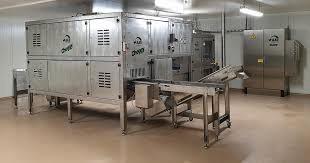 Hy-Line North America has installed Cheggy equipment produced by Agri Advanced Technologies of Germany in their hatcheries in Texas and Iowa. The technology applies hyperspectral imaging to distinguish between male and female embryos based on feather color at 13 days of incubation.
Hy-Line North America has installed Cheggy equipment produced by Agri Advanced Technologies of Germany in their hatcheries in Texas and Iowa. The technology applies hyperspectral imaging to distinguish between male and female embryos based on feather color at 13 days of incubation.
The Cheggy system unveiled on December 10th in the U.S., joins installations in seven E.U. nations. An installation with a footprint of approximately 300 square feet operates at 25,000 hatching eggs per hour and is compatible with current U.S. installations and procedures.
The Cheggy installations are infinitely less expensive and technologically simpler than alternatives requiring abstraction and assay of allantoic fluid for estrogen, denoting a female embryo.

In-Ovo sexing is a response to pressure exerted by animal welfare activists against destruction of cockerel chicks. Humane euthanasia of chicks is possible but misplaced sentiment has driven the initiative. The underlying motivation for advocates of In-Ovo sexing has less to do with welfare than it is opposition to intensive livestock production. It is axiomatic that extreme welfare advocates can never be placated and very soon the question of gender discrimination will arise together with the demand that In-Ovo sexing be conducted at an ever earlier stage in incubation. This could be achieved applying a system developed in Israel but would require insertion of a cassette of genes at the grandparent level. This is obviously resisted by primary breeders on the basis of genetic modification.
It is noted that the Cheggy system installed in the U.S. does not include the optional unit that euthanizes embryos by electrocution before disposal of embryonated eggs, as required by convention in some E.U. nations.
In-Ovo sexing will have limited application in the U.S. and will be confined to companies marketing eggs with claims for welfare and sustainability. Obviously in-ovo sexing with disposal of male-embryo bearing eggs does not provide any tangible benefits to consumers but will be reflected in a differential in-shelf price.